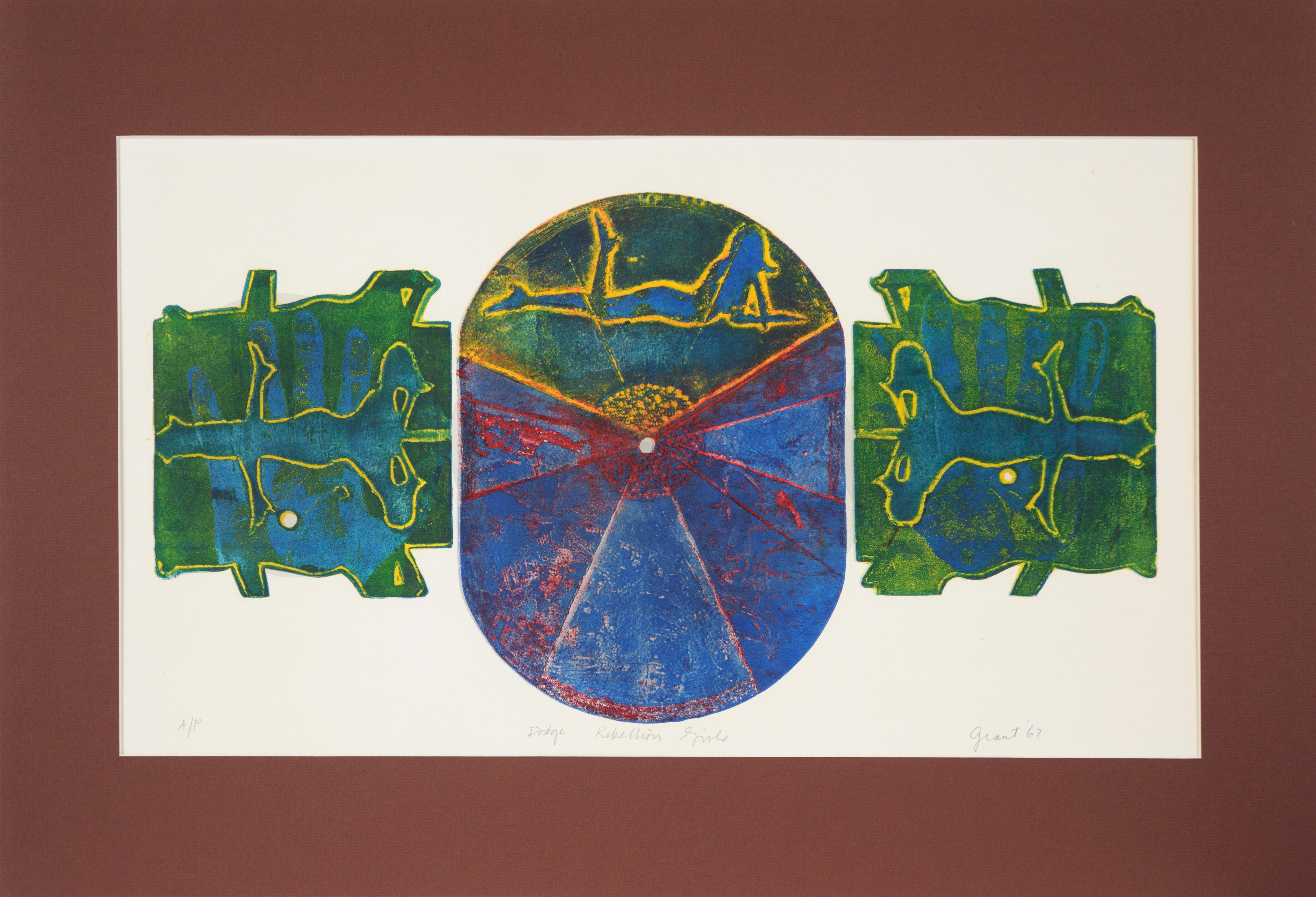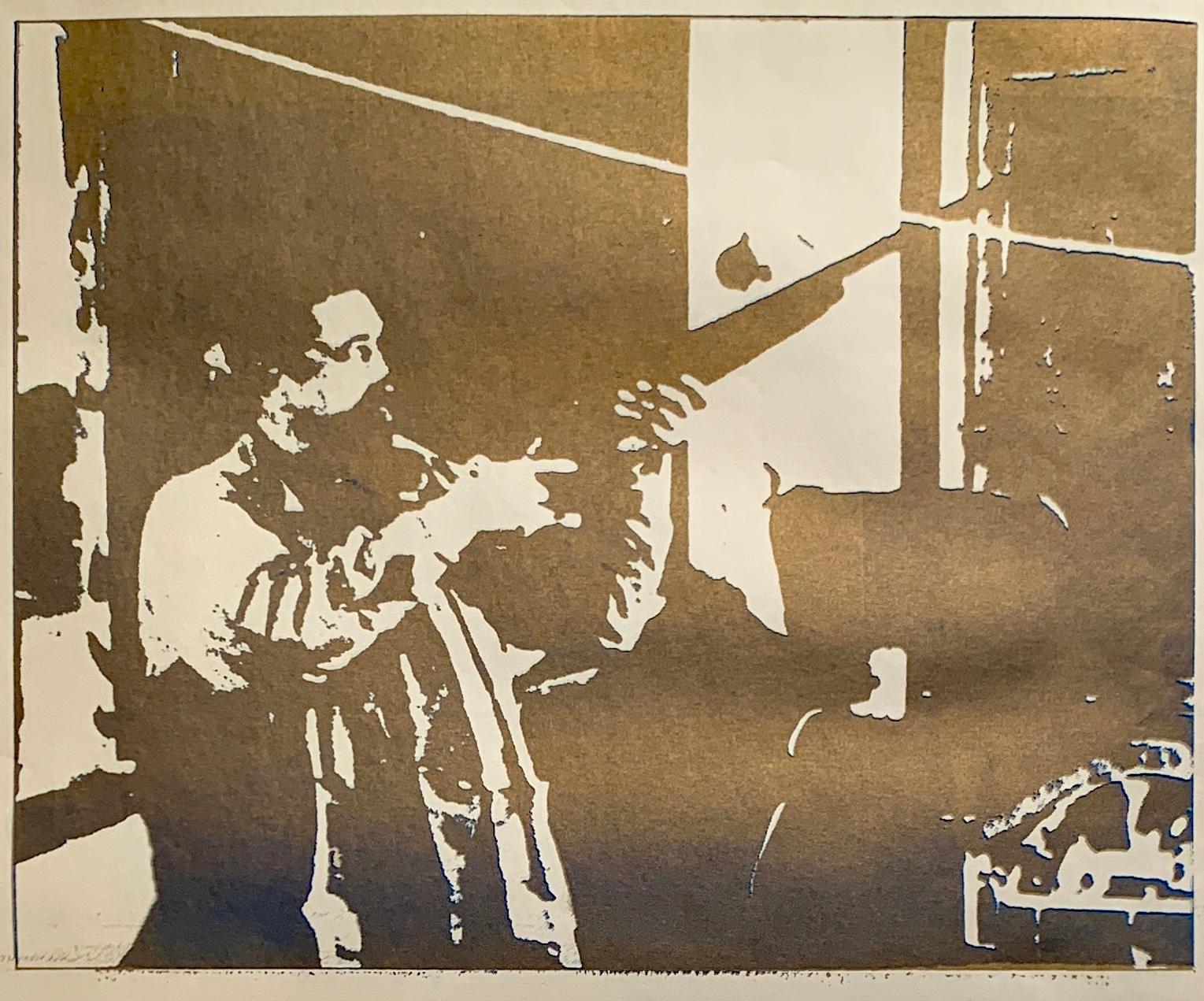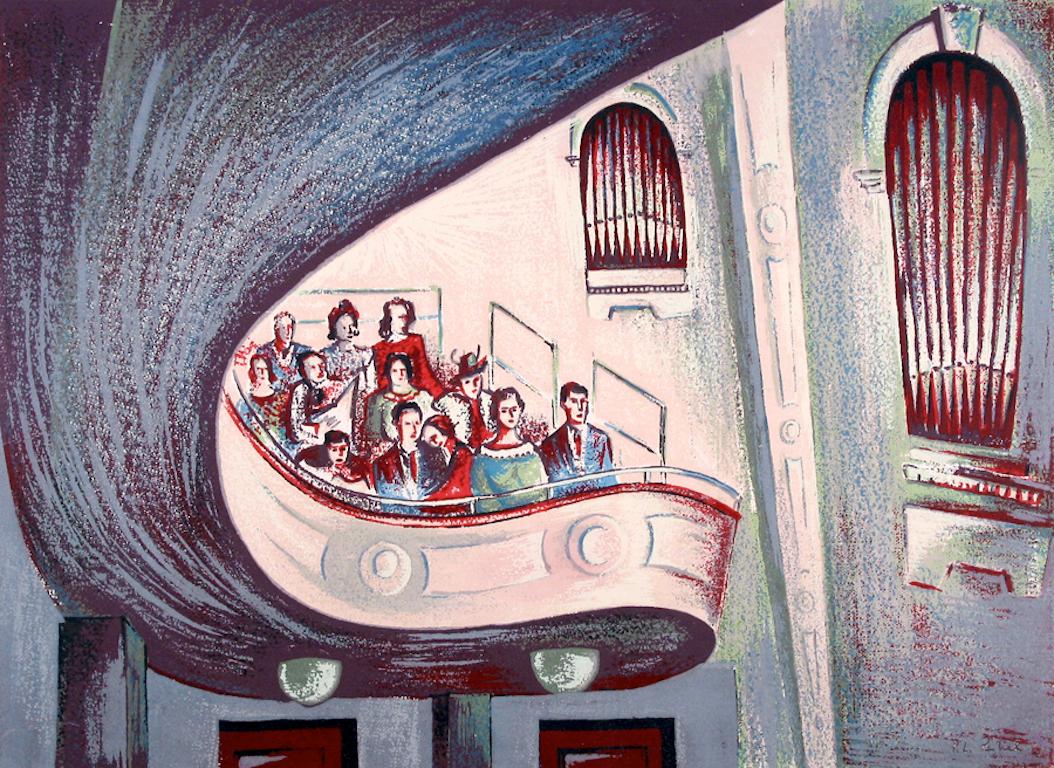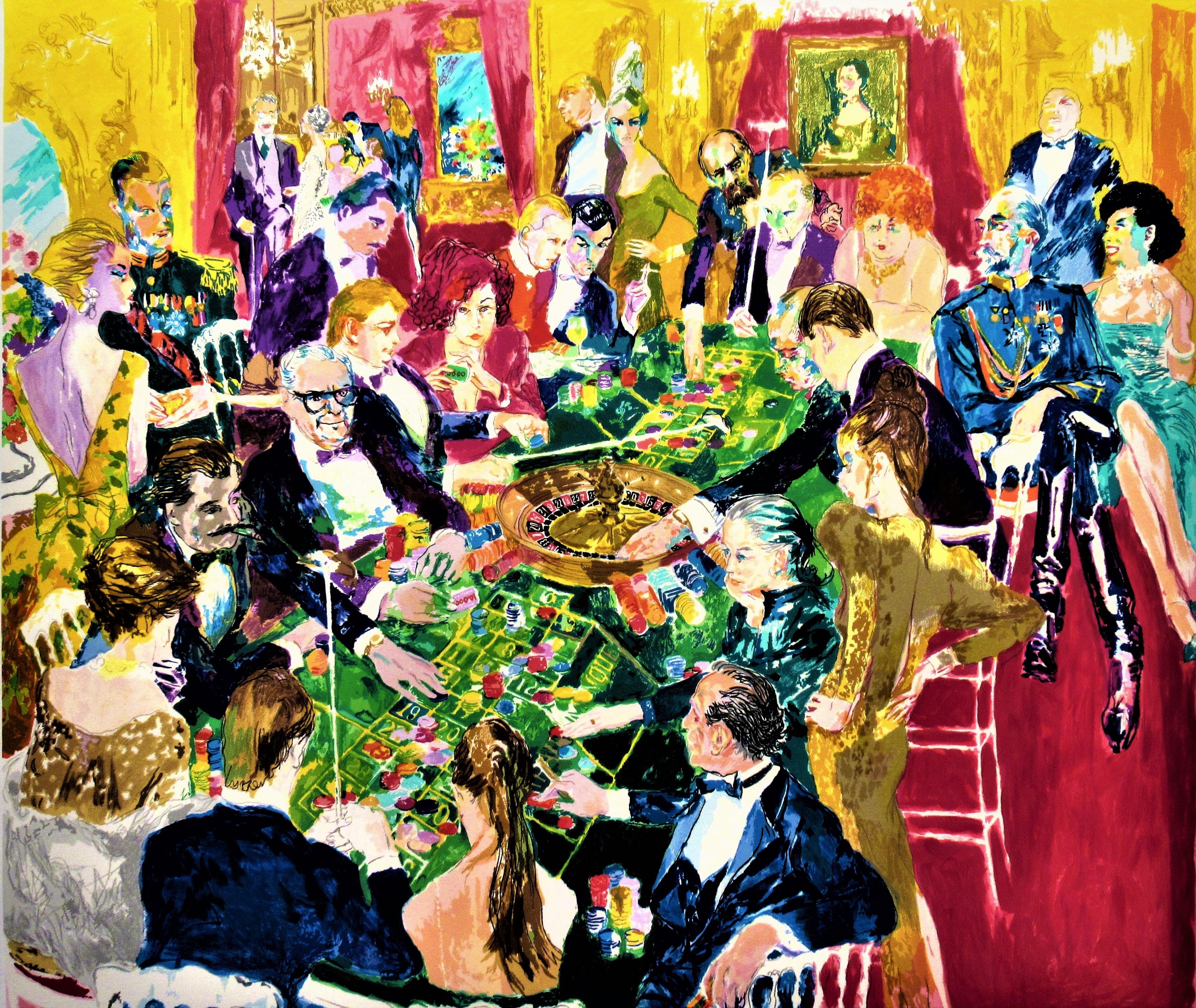
Performer Onstage, Silkscreen on Paper, Mid 20th Century
View Similar Items
1 of 1
Martin SnipperPerformer Onstage, Silkscreen on Paper, Mid 20th CenturyMid 20th Century
Mid 20th Century
About the Item
- Creator:Martin Snipper
- Creation Year:Mid 20th Century
- Dimensions:Height: 6.25 in (15.88 cm)Width: 5.5 in (13.97 cm)Depth: 0.1 in (2.54 mm)
- Medium:
- Movement & Style:
- Period:
- Condition:Minor wear.
- Gallery Location:San Francisco, CA
- Reference Number:Seller: 489711stDibs: LU29822553421
You May Also Like
- "The Capture, " Jacob Lawrence, Harlem Renaissance, Black Art, Haitian SeriesBy Jacob LawrenceLocated in New York, NYJacob Lawrence (1917 - 2000) The Capture of Marmelade (from The Life of Toussaint L'Ouverture series), 1987 Color screenprint on Bainbridge Two Ply Rag paper Sheet 32 1/8 x 22 1/16 inches Sight 29 3/4 x 19 1/4 inches A/P 1/30, aside from the edition of 120 Signed, titled, dated, inscribed "A/P" and numbered 1/30 in pencil, lower margin. Literature: Nesbett L87-2. A social realist, Lawrence documented the African American experience in several series devoted to Toussaint L’Ouverture, Frederick Douglass, Harriet Tubman, life in Harlem, and the civil rights movement of the 1960s. He was one of the first nationally recognized African American artists. “If at times my productions do not express the conventionally beautiful, there is always an effort to express the universal beauty of man’s continuous struggle to lift his social position and to add dimension to his spiritual being.” — Jacob Lawrence quoted in Ellen Harkins Wheat, Jacob Lawrence: The Frederick Douglass and Harriet Tubman Series of 1938 – 40. The most widely acclaimed African American artist of this century, and one of only several whose works are included in standard survey books on American art, Jacob Lawrence has enjoyed a successful career for more than fifty years. Lawrence’s paintings portray the lives and struggles of African Americans, and have found wide audiences due to their abstract, colorful style and universality of subject matter. By the time he was thirty years old, Lawrence had been labeled as the “foremost Negro artist,” and since that time his career has been a series of extraordinary accomplishments. Moreover, Lawrence is one of the few painters of his generation who grew up in a black community, was taught primarily by black artists, and was influenced by black people. Lawrence was born on September 7, 1917,* in Atlantic City, New Jersey. He was the eldest child of Jacob and Rosa Lee Lawrence. The senior Lawrence worked as a railroad cook and in 1919 moved his family to Easton, Pennsylvania, where he sought work as a coal miner. Lawrence’s parents separated when he was seven, and in 1924 his mother moved her children first to Philadelphia and then to Harlem when Jacob was twelve years old. He enrolled in Public School 89 located at 135th Street and Lenox Avenue, and at the Utopia Children’s Center, a settlement house that provided an after school program in arts and crafts for Harlem children. The center was operated at that time by painter Charles Alston who immediately recognized young Lawrence’s talents. Shortly after he began attending classes at Utopia Children’s Center, Lawrence developed an interest in drawing simple geometric patterns and making diorama type paintings from corrugated cardboard boxes. Following his graduation from P.S. 89, Lawrence enrolled in Commerce High School on West 65th Street and painted intermittently on his own. As the Depression became more acute, Lawrence’s mother lost her job and the family had to go on welfare. Lawrence dropped out of high school before his junior year to find odd jobs to help support his family. He enrolled in the Civilian Conservation Corps, a New Deal jobs program, and was sent to upstate New York. There he planted trees, drained swamps, and built dams. When Lawrence returned to Harlem he became associated with the Harlem Community Art Center directed by sculptor Augusta Savage, and began painting his earliest Harlem scenes. Lawrence enjoyed playing pool at the Harlem Y.M.C.A., where he met “Professor” Seifert, a black, self styled lecturer and historian who had collected a large library of African and African American literature. Seifert encouraged Lawrence to visit the Schomburg Library in Harlem to read everything he could about African and African American culture. He also invited Lawrence to use his personal library, and to visit the Museum of Modern Art’s exhibition of African art in 1935. As the Depression continued, circumstances remained financially difficult for Lawrence and his family. Through the persistence of Augusta Savage, Lawrence was assigned to an easel project with the W.P.A., and still under the influence of Seifert, Lawrence became interested in the life of Toussaint L’Ouverture, the black revolutionary and founder of the Republic of Haiti. Lawrence felt that a single painting would not depict L’Ouverture’s numerous achievements, and decided to produce a series of paintings on the general’s life. Lawrence is known primarily for his series of panels on the lives of important African Americans in history and scenes of African American life. His series of paintings include: The Life of Toussaint L’Ouverture, 1937, (forty one panels), The Life of Frederick Douglass, 1938, (forty panels), The Life of Harriet Tubman, 1939, (thirty one panels), The Migration of the Negro,1940 – 41, (sixty panels), The Life of John Brown, 1941, (twenty two panels), Harlem, 1942, (thirty panels), War, 1946 47, (fourteen panels), The South, 1947, (ten panels), Hospital, 1949 – 50, (eleven panels), Struggle: History of the American People, 1953 – 55, (thirty panels completed, sixty projected). Lawrence’s best known series is The Migration of the Negro, executed in 1940 and 1941. The panels portray the migration of over a million African Americans from the South to industrial cities in the North between 1910 and 1940. These panels, as well as others by Lawrence, are linked together by descriptive phrases, color, and design. In November 1941 Lawrence’s Migration series was exhibited at the prestigious Downtown Gallery in New York. This show received wide acclaim, and at the age of twenty four Lawrence became the first African American artist to be represented by a downtown “mainstream” gallery. During the same month Fortune magazine published a lengthy article about Lawrence, and illustrated twenty six of the series’ sixty panels. In 1943 the Downtown Gallery exhibited Lawrence’s Harlem series, which was lauded by some critics as being even more successful than the Migration panels. In 1937 Lawrence obtained a scholarship to the American Artists School in New York. At about the same time, he was also the recipient of a Rosenwald Grant for three consecutive years. In 1943 Lawrence joined the U.S. Coast Guard and was assigned to troop ships that sailed to Italy and India. After his discharge in 1945, Lawrence returned to painting the history of African American people. In the summer of 1947 Lawrence taught at the innovative Black Mountain College in North Carolina at the invitation of painter Josef Albers. During the late 1940s Lawrence was the most celebrated African American painter in America. Young, gifted, and personable, Lawrence presented the image of the black artist who had truly “arrived”. Lawrence was, however, somewhat overwhelmed by his own success, and deeply concerned that some of his equally talented black artist friends had not achieved a similar success. As a consequence, Lawrence became deeply depressed, and in July 1949 voluntarily entered Hillside Hospital in Queens, New York, to receive treatment. He completed the Hospital series while at Hillside. Following his discharge from the hospital in 1950, Lawrence resumed painting with renewed enthusiasm. In 1960 he was honored with a retrospective exhibition and monograph prepared by The American Federation of Arts. He also traveled to Africa twice during the 1960s and lived primarily in Nigeria. Lawrence taught for a number of years at the Art Students League in New York, and over the years has also served on the faculties of Brandeis University, the New School for Social Research, California State College at Hayward, the Pratt Institute, and the University of Washington, Seattle, where he is currently Professor Emeritus of Art. In 1974 the Whitney Museum of American Art in New York held a major retrospective of Lawrence’s work that toured nationally, and in December 1983 Lawrence was elected to the American Academy of Arts and Letters. The most recent retrospective of Lawrence’s paintings was organized by the Metropolitan Museum of Art in 2020, and was accompanied by a major catalogue. Lawrence met his wife Gwendolyn Knight...Category
1970s American Modern Figurative Prints
MaterialsScreen, Paper
$10,000 Sale Price20% Off - "Dodge Rebellion Girls" - 1967 Original Silkscreen on Paper Artists ProofBy Marc Foster GrantLocated in Soquel, CA"Dodge Rebellion Girls" - 1967 Silkscreen on Paper 1967 color silkscreen depicting the Dodge Rebellion Girls by Marc Foster Grant (American, b. 1947). A silhouette of the 'dodge gi...Category
1960s American Modern Figurative Prints
MaterialsPaper, Ink, Screen
- "Gold and Blue Gun" 1970s Original Portrait SilkscreenLocated in Arp, TXArtist unknown "Gold and Blue Gun" c. 1970s Silkscreen on paper Image size 21.25"x17" paper size 26"x40" unframed $350 Unsigned *Listed price reflects custom framing selected by sell...Category
1970s American Modern Figurative Prints
MaterialsPaper, Screen
- "Balcony" 1938 WPA Print Mid 20th Century American Broadway Theatre ModernismBy Leon BibelLocated in New York, NY"Balcony" 1938 WPA Print Mid 20th Century American Broadway Theatre Modernism. Silk screen on paper, 15” x 20". Numbered 15/20 lower left. Pencil si...Category
1930s American Modern Figurative Prints
MaterialsPaper, Screen
$6,000 Sale Price20% Off - Modernist Figurative Pop Art Etching and Aquatint "the Artist" Michael MazurBy Michael MazurLocated in Surfside, FLMichael Mazur "The Artist" Hand signed and editioned from the edition of 50 1967 Michael Burton Mazur (1935-August 18, 2009) was an American artist who was described by William Grimes of The New York Times as "a restlessly inventive printmaker, painter, and sculptor." Born and raised in New York City, Mazur attended the Horace Mann School. He received a bachelor's degree from Amherst College in 1958, then studied art at Yale. Mazur first gained notice for his series of lithographs and etchings of inmates in a mental asylum, which resulted in two publications, "Closed Ward" and "Locked Ward." Over the years, he worked in printmaking and painting. His series of large-scale prints for Dante's Inferno won critical acclaim, and were the subject of a traveling exhibition organized by the University of Iowa in 1994. Later he concentrated on creating large, lyrical paintings which make use of his free, gestural brushwork and a varied palette. Some of these paintings were seen in an exhibition of 2002 at Boston University, "Looking East: Brice Marden, Michael Mazur, and Pat Steir." (See also Susan Danly, "Branching: The Art of Michael Mazur," 1997). The Museum of Fine Arts, Boston, has acquired a definMichael Mazur received a B.A. from Amherst College in 1957, studying in his senior year at the Accademia di Belle Arti in Florence, Italy. He went on to earn both a B.F.A. and an M.F.A. from the Yale School of Art and Architecture in 1961. Mazur's first teaching job was at the Rhode Island School of Design from 1961 to 1964. He was awarded a Guggenheim Foundation fellowship for 1964–65. From 1965 to 1976, he taught at Brandeis University, and from 1976 to 1978 at Harvard University. As an artist, teacher, and writer, Mazur has been active in reviving the monotype process. He contributed an essay to the pioneering exhibition catalogue The Painterly Print, published by the Metropolitan Museum of Art in 1980. Mazur recently chaired the New Provincetown Print...Category
Early 2000s American Modern Abstract Prints
MaterialsLithograph, Screen
- The Cat, Signed Print by Will BarnetBy Will BarnetLocated in Long Island City, NYArtist: Will Barnet, American (1911 - 2012) Title: The Cat Year: 1997 Medium: Screenprint on Arches, signed in pencil Edition: AP Image Size: 16 x 7 inches Siz...Category
1990s American Modern Figurative Prints
MaterialsScreen
$1,600 Sale Price27% Off
Recently Viewed
View AllMore Ways To Browse
Sol Y Sombra
Tim Trantenroth
Tobiasse Rams Horn
Victor Brauner On Sale
Vintage Boulangerie Signs
Vintage Camra
Vintage Camras
Vintage Engagement Rings Phoenix
Vintage Oil Lamp With Lady
Virginia Fisher On Sale
Washerwoman Renoir
William Blake On Sale
Yashiva In Jerusalem
CHIKANOBU, Yoshu On Sale
Alex Katz Ada In Spain
Arnold Belkin On Sale
Art Deco Posters Liquer
Brexit Nightmare






